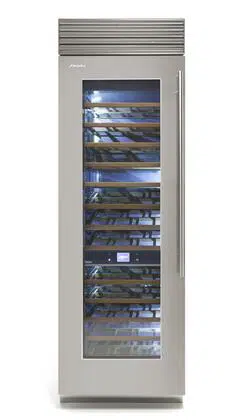Loading ...
Loading ...
Loading ...

www.fhiaba.com · www.thevettagroup.com · Info Line 1-855-4-FHIABA (1-855-434-4222)
6
1. IMPORTANT INSTRUCTIONS FOR SAFETY AND THE ENVIRONMENT
1.1 For your safety
> If this appliance is replacing an existing appliance
which must be removed or disposed of, make
sure that it does not become a dangerous trap
for children by cutting its power supply cable and
rendering it impossible to close the door. Use the
same caution at the end of the lifespan of the new
appliance.
> The appliance must be installed by following the
instructions in the Installation Guide, particular
care should be taken not to obstruct the vent
openings of the appliance and of the built-in units.
> The appliance features a concentrated lighting
system with LED lamps. Do not stare into these
lamps when they are on to avoid possible eyesight
damage.
This warning is also contained on the label attached
to the inside of the refrigerator door.
> Do not use any type of electrical equipment inside
of the food conservation compartments.
> When positioning the shelves, do not place fingers
in the shelf slide guides.
> Do not position containers of flammable liquids
near the appliance.
> Completely switch o the appliance and unplug
the power supply cable during cleaning operations.
If the plug is not easily reached, it is a good idea to
turn o the breaker or remove the fuse that controls
the socket that the appliance is connected to.
> The packaging material can be dangerous for
children: do not allow children to play with the
plastic bags, plastic film or Styrofoam.
> Any repairs must be performed by a qualified
Fhiaba Service technician.
> Do not damage the appliance refrigerant circuit
pipes.
> Repairs may be performed by the manufacturer,
service company or a similarly qualified person
only.
> Plug into a grounded 3 prong outlet.
> Do not remove ground prong.
> Do not use an adapter.
> Do not use an extension cord.
> Disconnect power to all units before servicing.
1.2 Important information when using
the appliance
> Never use electrical appliances inside the
appliance (e.g. heater, electric ice maker, etc.).
Explosion hazard!
> Never defrost or clean the appliance with a steam
cleaner! The steam may penetrate electrical parts
and cause a short-circuit. Risk of electric shock!
> Do not use pointed and sharp-edged implements
to remove frost or layers of ice. You could damage
the refrigerant tubes. Leaking refrigerant may
cause eye injuries or ignite.
> Do not store products which contain flammable
propellants (e.g. spray cans) or explosive substances
in the appliance.
Explosion hazard!
> Do not stand on or lean heavily against base of
appliance, drawers or doors, etc.
> Before cleaning the appliance, pull out the power
cord plug or switch o the fuse. Do not pull out the
power cord plug by tugging on the power cord.
> Store high-percentage alcohol tightly closed and
standing up.
> Keep plastic parts and the door seal free of oil and
grease. Otherwise, parts and door seal will become
porous.
> Never cover or block the ventilation openings for
the appliance.
To avoid contamination of food, please
respect the following instructions:
> Opening the door for long periods can cause
a significant increase of the temperature
in the compartments of the appliance.
> Clean regularly surfaces that
can come in contact with food
and accessible drainage systems.
> Store raw meat and fish in suitable
containers, so that it is not in
contact with or drip onto other food.
> If the refrigerating appliance is left empty
for long periods, switch o, clean, dry,
and leave the door open to prevent mould
developing within the appliance.
Symbols used in the Guide:
Note
Recommendations for correct use of the
appliance
Important
Directions for avoiding appliance damage
Warning
Indications for avoiding injury to people
Loading ...
Loading ...
Loading ...
